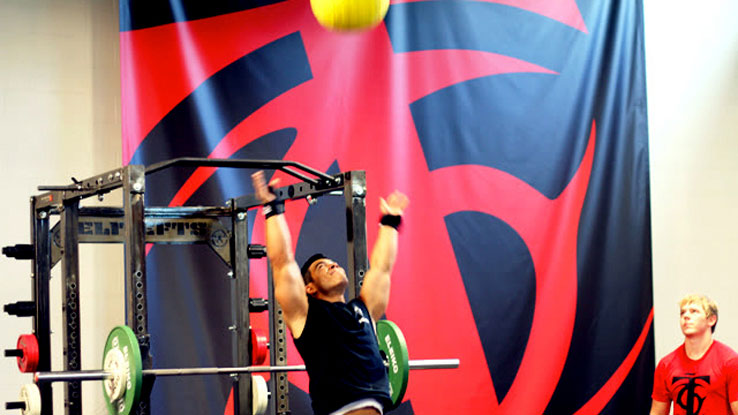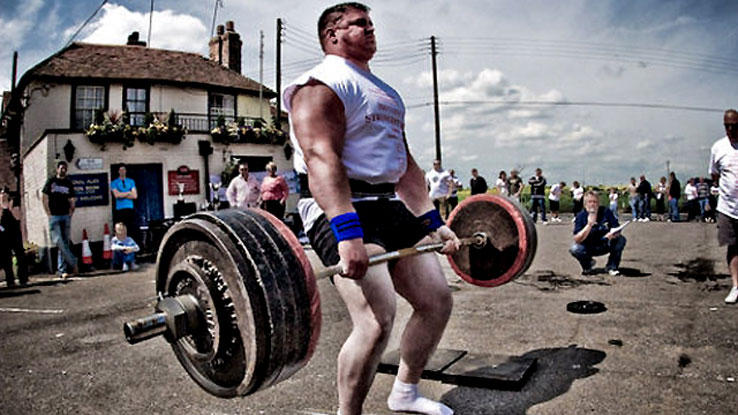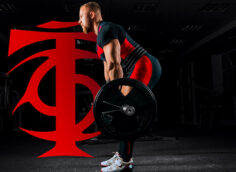Hard. Fast. Intense. Efficient.
While those terms could be used to accurately describe my romantic prowess as a high school lad, they also describe High Performance Training (HPT), a style of training that's gained considerable popularity in the past few years largely due to the proliferation of Crossfit boxes and functional movement-based gyms.
It appears that the proponents of HPT may be onto something. If you've been following the Indigo® Project, you'll notice that a lot of the techniques, implements, and training styles being used are also cornerstones of HPT.
Indigo Project strength coach Christian Thibaudeau sums up the methodology behind the Indigo workouts and why you should seriously consider using high performance based training:
"The new training system we're developing is based on maximizing body composition through high-performance training methods. By using explosive and high-tension work on a select few special exercises, we program the body for dramatic changes in muscle mass and leanness.
"The use of the Olympic lifts, power holds, jumps, ring exercises, basic strength lifts, and our own type of Prowler work creates the fastest physique changes possible. Not only that, by focusing on performance, your nervous system is amped up all day which improves your mood, overall well-being, focus, and mental performance."
Dramatic changes in muscle mass and leanness. The fastest physique changes possible. Improves mood, sense of well-being, focus and mental performance.
Who wouldn't want to be on this program?
It's tempting to jump up in front of your computer and yell "Sign me up, dammit. I'm ready for HPT." However, once you storm through the gym doors, you may encounter a few challenges.
What if you aren't all that comfortable with the Olympic lifts and don't have a world-class coach on hand to coach your technique? Or maybe you're great at the O-lifts but your gym doesn't have a Prowler. Maybe you have a great background on the rings from your high school gymnastics days but have never attempted a deadlift?
And perhaps, most importantly, you're thinking, "This is all new to me and I don't really understand how to program this combination of exercises in a way that I don't kill myself."
I'm here to help. In the table below is what I call The High Performance Training Matrix, a virtual take-out menu of exercises along with rep, set, and rest period recommendations that will allow you to create your own HPT program while working around any equipment or specific exercise limitations.
But with that in mind, here's my list of "not gonna's." This program is not gonna give you a 900 pound deadlift. It's not gonna get you ready for a body building show. It's not gonna fix your structural imbalances. If those are your goals you need to follow a program that follows a completely different approach.
What it is gonna do is deliver a high impact solution to increasing lean muscle mass and shedding body fat. And it's gonna be fun. "Holy crap, how did I survive that, where is the puke bucket" type of fun.
I recommend using this program anywhere from 2 to 5 days per week based on your training experience and recovery capabilities.
- Using the chart below select one exercise from column A. Complete all the reps and sets for that exercise for that week.
- Next, select two exercises from column B1/B2 and alternate between those two exercises until you've completed the prescribed reps and sets.
- The same goes for C1/C2, where you'll alternate between exercises.
- Finish up with the conditioning work found in column D.
You'll find all the recommended sets and reps for each week in the weekly periodization chart below. If you don't have certain pieces of equipment at your facility (such as a Prowler, medicine balls, or a rower), simply choose an exercise that uses dumbbells, a barbell, or a kettlebell.
If your gym doesn't have dumbbells, barbells, or kettlebells, use a Total Gym. And if you order one today, Chuck Norris himself will kick in your front door and set the damn thing up for you.
Nah, if barbells and dumbbells are in short supply you need to switch gyms. Seriously.
Weekly Periodization
| Exercise | Week 1 | Week 2 | Week 3 | Week 4 |
|---|---|---|---|---|
| A | 5 x 4 | 6 x 3 | 4 x 4 | 7 x 2 |
| B1/B2 | 4 x 6-8 | 5 x 4-6 | 3 x 8-10 | 6 x 3-4 |
| C1/C2 | 3 x 8-10 | 3 x 6-8 | 4 x 12-15 | 2 x 6-8 |
| D | 3 sets | 4 sets | 3 sets | 4 sets |
Exercise Selection
| A (Select 1) | B1/B2 (Select 2) | C1/C2 (Select 2) | D (Select 1) |
|---|---|---|---|
| Power Clean | Traditional Deadlift | Romanian Deadlift | 25 Kettlebell Swings |
| Power Snatch | (Weighted) Pull Up | Seated Overhead Dumbbell Press | 250m Row |
| Clean Pull/Jump Shrug | Front Squat | Single-Arm Dumbbell Row | 100m Sprint |
| Snatch Pull | Back Squat | Lunge (Forward, Reverse or Walking) | 50m Prowler Drive |
| Sandbag Clean | Military Press | Seated Cable Row | 40m Rope Pull |
| Overhead Medicine Ball Throw | Barbell Bench Press | Dumbbell Bench Press (flat or incline | 50m Farmers Walk |
| Kettlebell Clean & Press | Overhead Squat | Ring Muscle-Ups | 45 sec. Bike Sprints |
| Kettlebell Snatch | Bent-over Barbell Row | Split Squat | 20 sec. Battling Rope Intervals |
| Box Jump | Sumo Deadlift | Step-Ups | 10 Tire Flips |
Program Notes
- The intent during the concentric portion of each lift is to be fast/explosive, particularly for the exercises in Column "A."
- There are no rest interval prescriptions for this program. You should attempt the next set as soon as you feel capable of performing the set well without a drop-off in performance.
- That said, you'll likely have to rest longer in between sets of the exercises in columns "A" and "B" as they focus on explosive power and strength.
- For both "B1/B2" and "C1/C2" I highly recommend alternating between upper body and lower body movements within each workout and getting an equal amount of pushing movements (i.e. squats, military press, bench press) and pulling movements (i.e. pull up, deadlifts, rows) during your week.
- Obviously loads will vary based on the number of reps per set.
- You can either set your exercise selection to be static from week to week (i.e. every Monday is A) Power Clean, B1/B2) Front Squat, Bent-over Row, etc.) or you can change up the movements each time you train.
- I recommend keeping a detailed training log during this (and really, every) phase of training. With so much variety, it's good to have a record of your lifts so you have an idea of how to load the bar the next time that exercise appears in your program.

Here are two sample workouts constructed from the Matrix. Workout A assumes that you're training in a fully tricked-out performance-based training facility. Workout B would better suit those who train in a more conventional gym or health club setting.
Sample Week 2
Foam Rolling
Dynamic Warm-Up/Movement Prep
| Exercise | Sets | Reps | |
|---|---|---|---|
| A | Kettlebell Clean and Press | 6 | 3 |
| B1 | Sumo Deadlift | 5 | 4-6 |
| B2 | Barbell Bench Press | 5 | 4-6 |
| C1 | Split Squat | 3 | 6-8 |
| C2 | Ring Muscle Ups | 3 | 6-8/side |
| D | 50m Prowler Drive | 4 |
Note: Rest between sets is as much/little as needed.
Sample Week 4
Foam Rolling (if possible)
Dynamic Warm-up/Movement Prep
| Exercise | Sets | Reps | |
|---|---|---|---|
| A | Clean Pulls | 7 | 2 |
| B1 | Front Squat | 6 | 3-4 |
| B2 | Weighted Pull-Up | 6 | 3-4 |
| C1 | Step-Ups | 2 | 6-8/side |
| C2 | Seated Overhead Dumbbell Press | 2 | 6-8 |
| D | 100m Sprint | 4 |
Note: Rest between sets is as much/little as needed.
Just like any other program, your nutrition strategy should be based on your specific goals. However, as you can see from the samples above, these workouts are very demanding.
Proper peri-workout nutrition is a must, and you'd be best served by adopting one of the Anaconda Protocols. With these, every last ounce of guesswork has been removed from the equation – you just add water and make the best possible gains. For help with the rest of your diet check out my article Carb Cycling For The Non-Counter.
Given the variety of movements possible from one training session to the next, this program is ideal for those more aggressive with their training schedule. Still, if you're going to push your limits 4-5 times per week, your sleep and other recovery techniques best be on point.
Get at least 7-9 hours of sleep per night, include massage or other soft-tissue work as often as possible, and make sure you're supplementing your nutrient intake with fish oil and extra leucine.
The key to the High Performance Training Matrix is that it combines serious "bang for your buck" movements with appropriate set and rep schemes while also providing plenty of variety. That's what makes it effective, fun, and relatively low risk.
Now get after it, train hard, and prepare for some of the best changes in muscle mass, leanness, and focus you've ever experienced.





